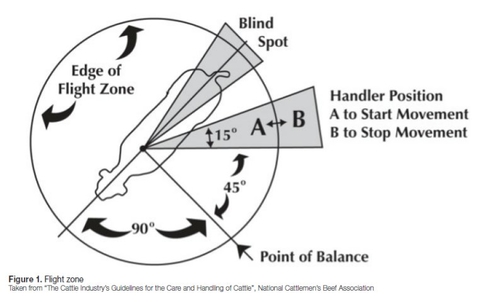Source: Elizabeth Griebel, ANR Extension Intern for Wright, McLeod and Meeker Counties
Understanding the impact of low-stress handling techniques in livestock improves animal performance and overall human safety. Moving cattle by using their natural behavior and instincts is an important key in handling livestock.
Beef Quality Assurance (BQA) is a program that provides information to U.S. beef producers on good husbandry techniques and knowledge to raise cattle under good management conditions (BQA). BQA states, “Improper handling that does not consider cattle behavior may lower conception rates, reduce immune and rumen functions, cause shipping fever and excess shrink and bruises requiring excess carcass trimming at the time of processing.” It is important to educate those working with livestock on proper animal care and handling techniques to ensure the health and overall well-being of the animals.
This image provided by BQA displays the flight zone of cattle and the blind spot. Understanding the flight zone and blind spot of animals is an important aspect when working with livestock. Standing in the blind spot may frighten the animal or cause them to charge forward or in the wrong direction when you are trying to move them. Standing in front of the point of balance can also cause the animal to become startled and turn around.
Upper Midwest Agricultural Safety and Health Center (UMASH), states, “Start cow movement by slowly approaching the cow’s pressure zone, give the cow time and space to react to you, and walk at a speed that keeps you out of the cow’s flight zone.” It is important to be informed about the flight zone of all species and animals that one is working with to ensure proper handling of livestock as all species and animals are different regarding handling.
The behavior of livestock animals is affected by both genetic factors and experiences. (Grandin, Livestock Handling and Transport). Many studies have displayed that measuring and continuing education on proper handling techniques will maintain meat quality and improve animal health and welfare. (Grandin, Livestock Handling and Transport). Cattle are herd animals, and they can become stressed when isolated from the majority of the herd. Cattle should be able to see you and be with the rest of the herd when moving livestock.
Remaining calm and quiet will allow the animals to be at ease while moving, allowing a safer environment for both the people and the animals. UMASH shares, “When moving cows, be PALS,” this means being patient, considering the angle, thinking about the location to the cow, and slowing the speed of your movement. (Upper Midwest Agricultural Safety and Health Center). All these ideas lead to improving animal welfare and maintaining the safety of the handlers and the animals.
For more information about safe cattle handling, please visit www.bqa.org to learn more about Beef Quality Assurance. BQA allows for producers to gain more knowledge about raising quality beef and improving production practices that assure cattle well-being and safety (BQA). For further information visit umash.umn.edu to learn more about improving health and safety across agricultural workers.


